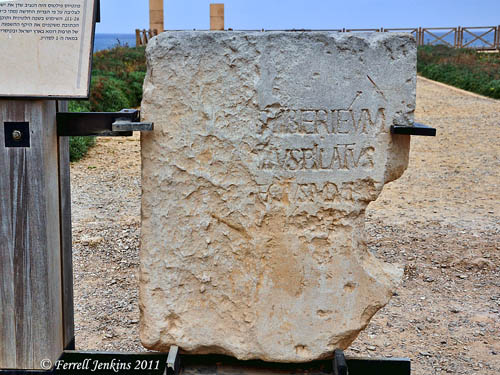'via Blog this'
Acts 4 — Photo Illustrations
In Acts 4 we have several public characters mentioned who had a part in the trial of Jesus or in the opposition to the new movement of believers in Jesus as Lord and Christ (Acts 2:36). I will call attention to two of them. The first is a religious leader, and the second is one of the Roman procurators or prefects.
Caiaphas. Caiaphas was the son-in-law of Annas. He was appointed high priest by Valerius Gratus, procurator of Judea, in A.D. 18 and deposed by Vitellius, legate of Syria, in A.D. 36 at the same time Pilate was removed as procurator of Judea. Caiaphas was the Jewish high priest before whom Jesus was tried (John 18:13-14, 24).
In November, 1990, a burial cave was found accidentally during construction of a water park at a promenade overlooking the Peace Forest just south of the old city of Jerusalem. The cave contained 12 ossuaries, two of which contained the name of the well-known family of the high priest Caiaphas. One ossuary bore the inscription Qafa, and the other bore the name Yehosef bar Qayafa (Joseph, son of Caiaphas) and Yehosef bar Qafa (Joseph, son of Caiaphas). Inside this beautiful ossuary was found the bones of six different people: 2 infants, a child between 2 and 5, a young boy between 13 and 18, an adult woman and “a male of about 60 years!”
According to Josephus, Caiaphas was named Joseph Caiaphas (Ant. 18.2.2).
The Caiaphas ossuary is on display in the Israel Museum. (See articles: Zvi Greenhut, “Burial Cave of the Caiaphas Family,” BAR 18.5 (1992): 29-36. Ronny Reich, “Caiaphas Name Inscribed on Bone Boxes,” BAR 18.5 (1992): 38-44.)
Pontius Pilate. Pilate was the Roman procurator of Judea when Jesus was crucified (A.D. 26-36). An inscription bearing the name of Pilate was discovered at Caesarea, the residence of the procurator, in 1961. The stone is thought to have been used in the dedication of a statue or some public building. The original is in the Israel Museum but a replica is displayed at Caesarea.
Murphy-O’Connor suggests the following translation of the Latin inscription: “Pontius Pilate, Prefect of Judaea, made and dedicated the Tiberieum to the Divine Augustus” (The Holy Land, 3rd ed., 215).
The Roman historian Tacitus (A.D. 55-117) writes about the persecution of a group commonly called Christians. He says the originator or author of the group,
Christ, was put to death by the procurator, Pontius Pilate, while Tiberius was emperor…
See John 18:28ff.



No comments:
Post a Comment